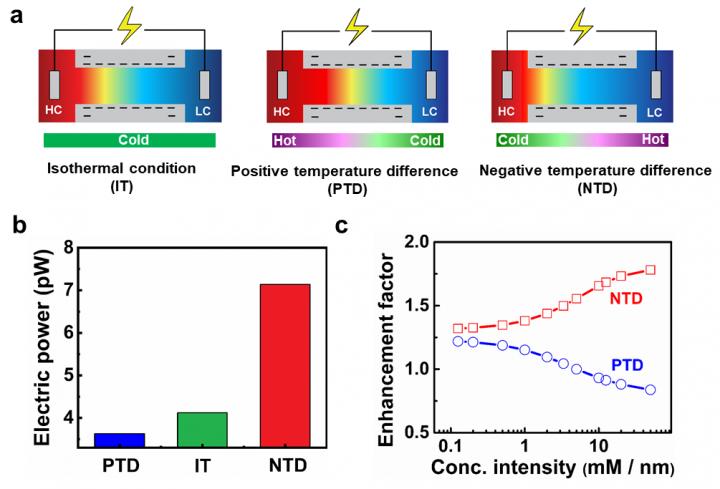Ionic thermal up-diffusion boosts energy harvesting

(a) Schematic illustration of the ion concentration profiles with asymmetric transmembrane temperature differences. (b) Electric power under different temperature differences. (c) At small transmembrane concentration intensities, both positive and negative temperature differences contribute to the electric power. At high transmembrane concentration intensities, a negative temperature difference promotes the power extraction and a positive temperature difference hinders the electric power. Credit: ©Science China Press
Previous efforts focusing on the nanofluidic energy conversion system mainly deal with the isothermal conditions. Conventional viewpoint suggests that improving the membrane potential requires a larger temperature and a long channel length to guarantee a large selectivity and a high effective concentration difference.
This intuitive judgement accounts for increasing temperature to achieve better performance. However, the transmembrane temperature difference is a very important, yet long-overlooked element that impacts the performance of the nanofuidic devices.
In a new research article published in the Beijing-based National Science Review, scientists at Huazhong University of Science and Technology, China present an anomalous temperature dependence in nanofluidic power generation.
A negative temperature difference can significantly improve the membrane potential due to the impact of ionic thermal up-diffusion that promotes the selectivity and suppresses the ion concentration polarization, especially at the low concentration side, which results in dramatically enhanced electric power. Simple and efficient ways are also proposed to fabricate tunable ionic voltage sources and enhance salinity gradient energy conversion based on small nanoscale biochannels and mimetic nanochannels.
“Scientifically, we reveal the importance of a long-overlooked element, transmembrane temperature difference, in nanofluidic salinity gradient energy harvesting.” Prof. Wei Liu said, “For applications and guidance, we can fabricate tunable ionic voltage sources, where the voltage is tuned by the temperature at the low concentration side and the internal resistance adjusted by the temperature at the high concentration side. And waste heat can be employed to enhance the power output and ionic flux by establishing transmembrane temperature difference to match the optimal transmembrane concentration intensity under the nanoscale biochannels and mimetic nanochannels.”
###
This research received funding from the National Natural Science Foundation of China.
See the article:
Rui Long, Zhengfei Kuang, Zhichun Liu, and Wei Liu
Ionic thermal up-diffusion in nanofluidic salinity gradient energy harvesting
Natl Sci Rev 2019; doi: 10.1093/nsr/nwz106 https:/
The National Science Review is the first comprehensive scholarly journal released in English in China that is aimed at linking the country's rapidly advancing community of scientists with the global frontiers of science and technology. The journal also aims to shine a worldwide spotlight on scientific research advances across China.
Media Contact
More Information:
http://dx.doi.org/10.1093/nsr/nwz106All latest news from the category: Materials Sciences
Materials management deals with the research, development, manufacturing and processing of raw and industrial materials. Key aspects here are biological and medical issues, which play an increasingly important role in this field.
innovations-report offers in-depth articles related to the development and application of materials and the structure and properties of new materials.
Newest articles

Silicon Carbide Innovation Alliance to drive industrial-scale semiconductor work
Known for its ability to withstand extreme environments and high voltages, silicon carbide (SiC) is a semiconducting material made up of silicon and carbon atoms arranged into crystals that is…

New SPECT/CT technique shows impressive biomarker identification
…offers increased access for prostate cancer patients. A novel SPECT/CT acquisition method can accurately detect radiopharmaceutical biodistribution in a convenient manner for prostate cancer patients, opening the door for more…

How 3D printers can give robots a soft touch
Soft skin coverings and touch sensors have emerged as a promising feature for robots that are both safer and more intuitive for human interaction, but they are expensive and difficult…





















